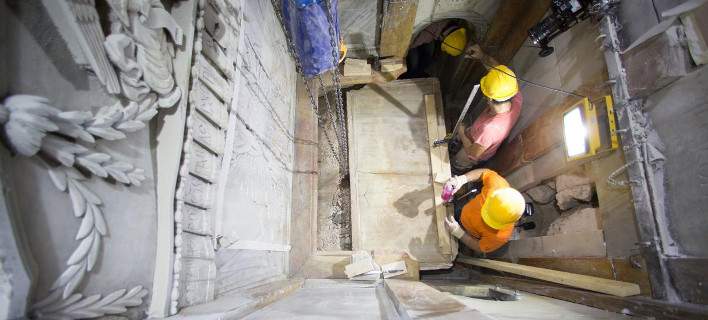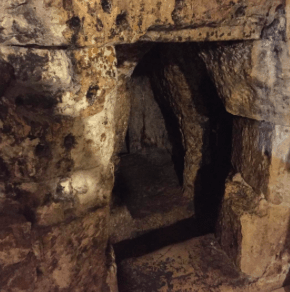
After making the astonishing discovery of the stone shelf on which the body of Jesus is thought to have been placed, the restoration work carried out to restore the Edicule surrounding Jesus' tomb, in the Church of the Holy Sepulchre in Jerusalem, is now at its most crucial stage.
The restoration work is being carried out by the University of Athens (NTUA) and is headed by Antonia Moropoulou. According to Moropoulou, the team was now at the "heart" of the project's development in what she described as an "overwhelming experience."
"On October 26 we rolled back the slab of the Holy Sepulchre given that we were completing the phase of the injections and had to protect the Holy Rock. Under the marble slab of Calfas Komninos, the famous architect that carried out the restoration of the tomb in 1810 (after the fire of 1808) we found another slab that was probably from the crusades - this is evidenced by the characteristic Crusaders cross that it bore. Underneath we found the stone shelf on which the body of Jesus is thought to have been placed.
 "We opened a window so that the Holy Rock will always be visible to visitors. Now we are in the final stages of the project, which are to reattach the marble and stone decorative plates that we removed in order to stably restore the Edicule, in a way that ensures the monument's integrity and the sustainability of the solution we provide. Given that the cause of the Edicule's deformation remains: it is no longer the rain water that for years fell from the dome of the Church of the Holy Sepulchre - the dome has today been sealed - but the waters rising from underground, from a complex that connects the entire church with underground canals," Moropoulou said.
"We opened a window so that the Holy Rock will always be visible to visitors. Now we are in the final stages of the project, which are to reattach the marble and stone decorative plates that we removed in order to stably restore the Edicule, in a way that ensures the monument's integrity and the sustainability of the solution we provide. Given that the cause of the Edicule's deformation remains: it is no longer the rain water that for years fell from the dome of the Church of the Holy Sepulchre - the dome has today been sealed - but the waters rising from underground, from a complex that connects the entire church with underground canals," Moropoulou said.
She also referred to the unique and deeply moving experience that the project provided for the Greek team, as well as the grave responsibility that they bore.
"Next to the Holy Sepulchre, as part of the project, we have set up an interdisciplinary laboratory. We want the findings that we announce to be the property of the entire world. What makes us all so moved is that the Tomb of Christ is a living tomb. It sends forth a message of resurrection and hope and that is what has affected us and enabled us to work," she told Greek media
The interdisciplinary team's work on the tomb began in June this year, following an invitation from Jerusalem Patriarch Theophilos to the NTUA. The Patriarch had first obtained the agreement of the other two religious communities that share in the site's management, the Franciscan order and the Armenian Patriarchate in Jerusalem. The team is led by Moropoulou, a chemist and includes architecture professor Manolis Korres, civil engineering professor Constantinos Spyrakos and land surveyor Andreas Georgopoulos. The team had presented its plans in January 2016 in Jerusalem, in the presence of the prime minister, and then in February to the leaders of the three religious communities responsible for the church, as well as to an audience in Athens in March.



It was never missing. We always knew where the tomb was. The actual slab was just under the other slabs within the Holy Sepulchre…